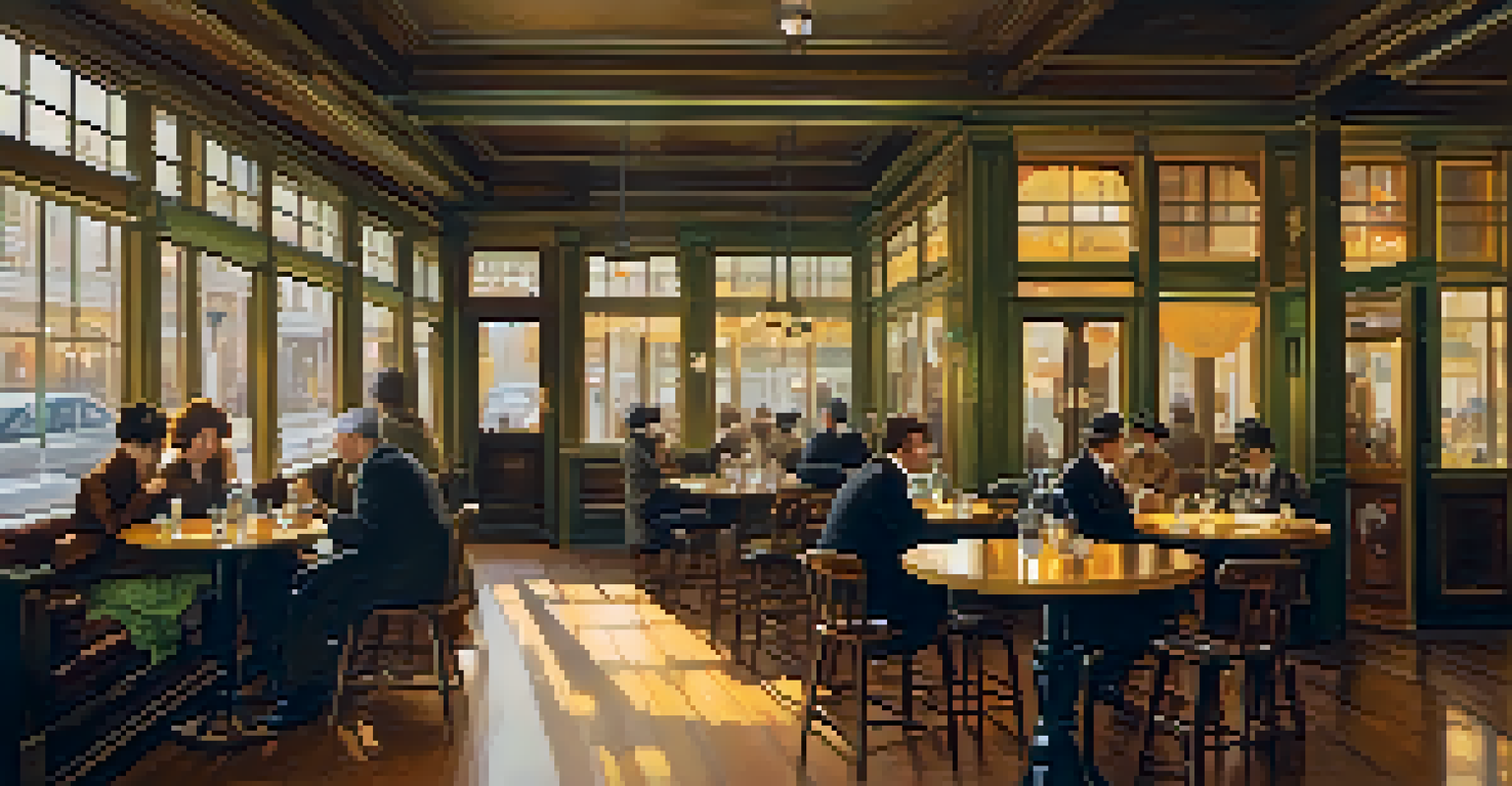Comparative Study: Impressionism and Post-Impressionism

Understanding Impressionism: Key Characteristics
Impressionism emerged in the late 19th century, characterized by its focus on capturing light and natural scenes. Artists like Claude Monet and Edgar Degas emphasized the effects of light on color, often painting en plein air, or outdoors. This movement marked a departure from the detailed realism of earlier art forms, allowing for a more spontaneous and emotive expression.
Impressionism is not a movement, but a way of seeing.
One of the defining traits of Impressionism is its loose brushwork. Rather than meticulously blending colors, Impressionist artists applied paint in quick, visible strokes. This technique created a sense of movement and immediacy, inviting viewers to experience the scene as if they were part of it.
Additionally, Impressionism often features everyday subjects—landscapes, urban scenes, and moments of leisure—reflecting the life of the time. This focus on contemporary life made the genre relatable, drawing audiences into the world around them.
Post-Impressionism: A New Direction in Art
Post-Impressionism emerged as a reaction to Impressionism, developing from the late 1880s onward. Artists like Vincent van Gogh, Paul Cézanne, and Georges Seurat sought to delve deeper into color, form, and emotional expression. This movement maintained the vibrant colors of Impressionism but emphasized structure and meaning over mere visual impressions.

A key feature of Post-Impressionism is its focus on the artist's subjective experience. Unlike Impressionists, who aimed to capture fleeting moments, Post-Impressionists often infused their work with personal symbolism and emotional depth. For instance, Van Gogh’s swirling skies in 'Starry Night' evoke intense feelings, transcending the ordinary.
Impressionism Captures Light and Life
Impressionism focuses on depicting natural scenes and the effects of light, using loose brushwork to create a sense of spontaneity.
Moreover, Post-Impressionists began experimenting with techniques and styles, paving the way for modern art movements. Cézanne's geometric forms and Seurat's pointillism transformed how artists approached composition and color, challenging traditional perceptions of art.
The Role of Color in Impressionism vs. Post-Impressionism
Color plays a crucial role in both Impressionism and Post-Impressionism, but the approach differs significantly. Impressionists used color to capture the effects of light and atmosphere, often applying complementary colors side by side to create vibrancy. This technique allowed them to portray the transient qualities of a scene.
Color is the keyboard, the eyes are the harmonies, the soul is the piano with many strings.
In contrast, Post-Impressionists viewed color as a means of expression rather than just a reflection of reality. For example, Van Gogh’s bold, expressive colors were used to convey emotion, often deviating from the natural hues. This use of color became a tool for personal expression, giving each artwork a unique emotional resonance.
Additionally, while Impressionists often blended colors to achieve a soft, atmospheric effect, Post-Impressionists employed bolder, more defined colors to create structure. This shift not only changed how artists approached their palettes but also how viewers experienced the artwork.
Themes and Subjects: Everyday Life vs. Emotional Depth
Impressionism primarily focuses on scenes from everyday life, capturing fleeting moments of leisure, nature, and urban life. This emphasis on ordinary subjects made art more accessible and relatable to the general public. The movement sought to document modern life just as it was, evoking a sense of nostalgia and familiarity.
On the other hand, Post-Impressionism introduced a broader range of themes, delving into the psychological and emotional landscapes of the artist. Works often reflect more personal narratives and deeper existential themes, moving beyond mere representation. This shift allowed artists to explore their inner worlds, inviting viewers to engage with art on a more profound level.
Post-Impressionism Deepens Emotional Art
Post-Impressionism evolves from Impressionism by emphasizing the artist's emotional experience and personal symbolism in their work.
For instance, while an Impressionist painting may depict a sunlit garden, a Post-Impressionist work may use that garden as a metaphor for the artist’s emotional state. This exploration of themes laid the groundwork for future movements, such as Expressionism and Surrealism.
Techniques: Brushwork and Composition Differences
The brushwork of Impressionism is characterized by loose, rapid strokes that convey spontaneity and movement. Artists often left brush marks visible, creating a sense of immediacy and capturing the essence of a scene rather than its detailed reality. This technique is particularly evident in Monet’s landscapes, where the interplay of light and color takes center stage.
Post-Impressionists, however, took a more structured approach to composition, experimenting with form and perspective. Artists like Cézanne employed geometric shapes and planes, transforming how subjects were represented. This focus on structure allowed for a deeper exploration of spatial relationships, setting the stage for future modern art movements.
Moreover, while Impressionists often painted en plein air, seeking to capture the moment, Post-Impressionists frequently worked in studios, allowing for more contemplation and deliberation in their compositions. This difference in approach highlights the evolution of artistic intent from Impressionism to Post-Impressionism.
Influence of Impressionism on Post-Impressionism
Impressionism laid the groundwork for Post-Impressionism, influencing how artists approached color, light, and subject matter. The freedom to explore beyond traditional techniques allowed Post-Impressionist artists to push boundaries and express themselves more personally. This evolution marked a pivotal moment in the history of art.
Many Post-Impressionists were directly inspired by the works of Impressionist masters, adopting their vibrant palettes and innovative techniques. However, they sought to expand these ideas, introducing their own interpretations and emotional depth. For instance, Van Gogh admired Monet’s use of color but infused it with his unique emotional intensity.
Legacy of Innovation in Art History
Both Impressionism and Post-Impressionism have significantly influenced modern art movements, encouraging innovation and personal expression among artists.
This interplay between the two movements illustrates how art evolves, with each generation building on the ideas of the last. The legacy of Impressionism can be seen in the bold experiments of Post-Impressionism, ultimately paving the way for modern artistic expressions.
The Legacy of Impressionism and Post-Impressionism
The impact of Impressionism and Post-Impressionism on the art world is undeniable. These movements challenged traditional conventions, encouraging artists to explore new techniques and themes. They opened the door for subsequent modern art movements, influencing countless artists and reshaping the landscape of visual art.
Today, the legacies of both movements continue to resonate, inspiring contemporary artists to embrace innovation and personal expression. The emotive power of color and form found in these works remains relevant, encouraging new generations to explore their artistic voices.

Furthermore, museums and galleries around the world showcase the masterpieces of Impressionism and Post-Impressionism, allowing audiences to connect with these transformative periods in art history. This enduring interest underscores the significance of these movements in the broader narrative of art.